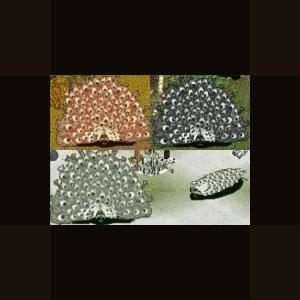About This File
Three habitat-themed peafowl for your zoos: Arctic - the Tundra Peafowl; Savannah - the White-eyed Kenyan Peafowl; and Highlands - the Asian Shadowfowl. The Savannah and Highlands peafowl are both compatible with in-game animals.
Tundra Peafowl
Nicknamed the mint, or ice mint peacock, this interesting fellow is found on the borderlands tundra. Much like many tundra inhabitants, this bird shrugs of its boring brown coloring for a white shroud in the winter.
Unlike the other inhabitants, the male doesn't wear the usual all white or brown and white coloring. Instead it dons feathers of iridescent green and white, perhaps to give the illusion of grass peeking up through snow.
The Tundra peafowl has a very dense layer of down feathers for warmth. This gives the bird a beefier look compared to other peafowl.
The temperament of the bird is slightly more aggressive than the normal array of peafowl. This probably stems from the fact that the bird has to deal with more land predators, there aren't many trees to roost in on the wide, open tundra.
They've been known to bully the ptarmigan for nesting spots and food.
White-eyed Kenyan Peafowl
An African sunset, the grasses painted golden, the sky a mixture of red, orange, and yellow. The earth itself has taken on an amber cast.
This gorgeous specimen seems to have taken that image and painted it onto its tail.
The bird itself is found throughout the savannah of Africa, though it was first described in Kenya.
The first bird was reportedly found in a snare and was thought to either be a sunbleached released bird, or a subadult. Occasional sightings of 'peacock-like' birds were reported. It wasn't until a male was caught by a naturalist that anyone took notice.
Kenyan Peafowl eat fruit, seeds, insects, the occasional lizard. During the day they search in shorter grasses for their favorites. They are usually found within reach of trees of height. Should they be startled, they take immediate flight.
At night they roost, usually in thorn acacias. The ants and thorns don't seem to be a deterrent.
Mating season is a time of high mortality rate for the males. Nothing says 'come eat me' like pick-up lines, dancing, and displaying.
Females will hunt out ostrich nesting sites, nesting close by. Nothing deters the big predators like having an huge cousin as a (unknowing) bodyguard.
*100% compatible with the in-game ostrich. NOTE: The screenshot shows 10 filled squares of foliage, though the ostrich says it only likes three. You'll find that the exhibit suitability for the ostrich is higher this way. As shown, the ostrich's suitability is 95%, with a 100% suitability for the peafowl.
Asian Shadow Peafowl aka Asian Shadowfowl
The proper name for this coloration is melonistic peafowl with the 'white-eyed' gene at work, however, few call it that. Panda, shadow, black, night, or leopard are but a few nicknames for it. Birds of this shade prefers to stick to the shade, hence their most commonly-known name, Shadowfowl. Some of these peafowl even go as far as coming out only at evening and at dusk.
This striking peafowl variation lives in the highlands side-by-side with the gentle giant panda, and even with Asian black bears. They need plenty of elevation, and will enjoy having a shelter in their exhibit, even though the do not require one.
NOTE: 100% compatible with the in-game Giant Panda, but will also happily share an exhibit with the Asian Black Bear.
Updated 2010-11-21
Just to save space with less in zip and smaller image.
Nothing new.



Recommended Comments
There are no comments to display.
Create an account or sign in to comment
You need to be a member in order to leave a comment
Create an account
Sign up for a new account in our community. It's easy!
Register a new accountSign in
Already have an account? Sign in here.
Sign In Now